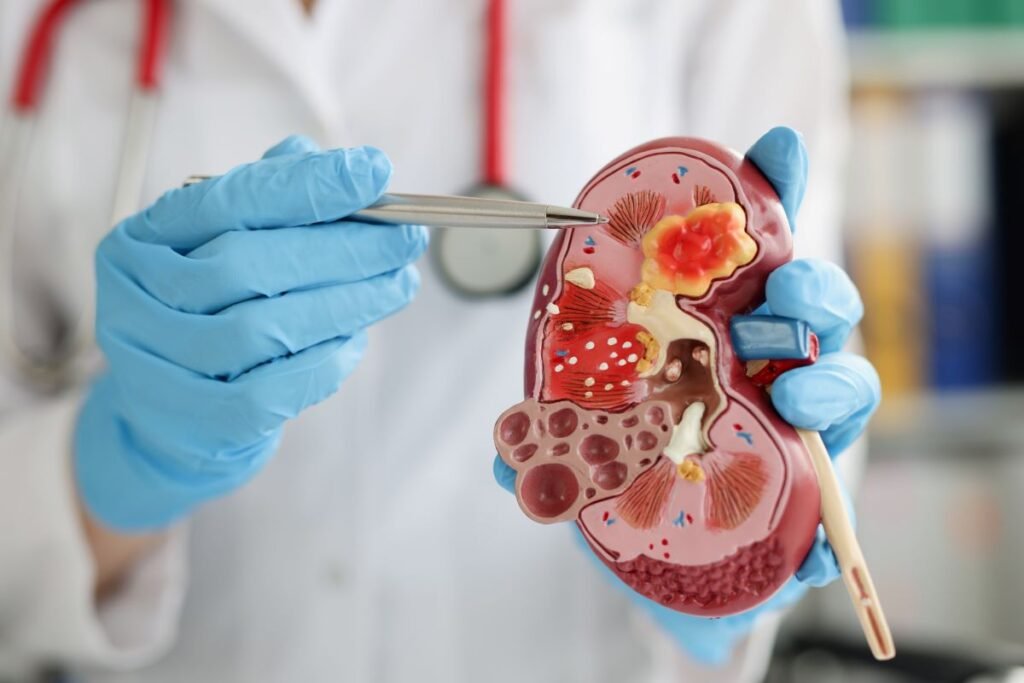Urinary tract infection
Introduction
Kidney stone disease is a common condition that affects individuals in all countries and ethnic groups. In the United Kingdom, the circulation is about 1.2%, with a lifetime risk of developing kidney stone until about 7% estimated in men. However, in some regions, the risk in Saudi Arabia is significantly higher – most, where lifelong risk for men in the same age group is more than 20%.

Types of Urinary tract infection
Urethritis
Infection of the urethra
Symptoms: Sensation of irritation during urination, discharge
Cystitis
bladder infection
Symptoms: persistent urge to urin, abdominal pain, cloud or bloody urine
Pylonphritis
Renal infection
Symptoms: Fever, chills, back/flank pain, nausea, vomiting, fatigue
Diracheitis
Infection of urerators
Often with kidney infection
Causes UTI (Urinary tract infection)
- The main causes of urinary tract infection are bacteria that live around the anus. During infection, these bacteria can move forward in the bladder in the bladder and spread to the kidneys.
- Sexual interrelations are also responsible for urinary tract infections.
- To avoid pregnancy, women use diaphragm that can also give rise to these infections.
- Some complications such as menopause and spinal cord injury are also associated with urinary tract infection.
- It has been observed that immune agreement patients (HIV/diabetes) are more prone to these infections.
- Hospitals are also the main cause of urinary tract infection. A clinical method designated as a catheterization, a tube is inserted in the urethra to those who have problems while urinating
- Analgesics like ibuprofen, aspirin and naproxen may also lead to kidney damage.
Clinical features of UTI:
Convertible presentation:
- Some patients are touching.
- Others are present with pain, hematuria, urinary tract infection (UTI), or urinary obstruction.
General presentation - Kidney or Urector Shul:
- Usually caused by a stone (stones) due to the ureter barrier.
- A slow kidney papilla, can also be caused by blood clots or tumors.
Pain characteristics:
- Sudden onset of acute loin pain.
- The pain occurs from the flank to the waist, sometimes in the testis (in men) or the labium (in women).
- The first lumbar nerve (L1) follows the sensory distribution.
- The intensity is quickly formed, at the peak within minutes.
Related symptoms:
Restlessness and constant movement to get relief, often unsuccessful.
Palor, sweat, and vomiting are common.
Dysuria may be the frequency of urination, and visual or micro -hematuria.
Pain duration and pattern:
- Severe pain is usually solved within 2 hours, but can last from hours to days.
- Pain is usually stable during attacks with minor ups and downs.
- After the acute phase, an intermittent pain in a dull, loan or back can persist for several hours.
Symptoms associated with chronic kidney diseases
- There is a burning sensation during urination.
- The color of urine can be red or light pink.
- There is a strong odor in the urine.
- Sleep
- vomit.
- In severe cases, when the infection reaches the kidney, there may be any fever and cold
Investigations in chronic kidney
Confirm the presence of a stone
Identify the location of the stone
Assess if it is causing urinary obstruction
Plain belly X-ray (kub):
Radio-OPEC detect stones (especially calcium-containing, ~ 90% stones)
Non-contrast CT Kub (Kidney, Urators and Bladder CT):
Gold standard for diagnosis Can detect 99% of all stones regardless of the composition
- Ultrasound:
- Recipes detect renal stones and hydronephrosis Useful in pregnant women and unstable patients (to avoid radiation risk)
A minimum set of tests is recommended (as per the box 18.50)
Urinary tests, blood tests and imaging include
Detailed metabolic evaluation is usually reserved for high risk patients (eg, recurrent stone, family history)
Chemical analysis of passed stone helps identify the underlying cause
Patients should sieve the urine for a few days after an attack to collect and analyze the stone.
